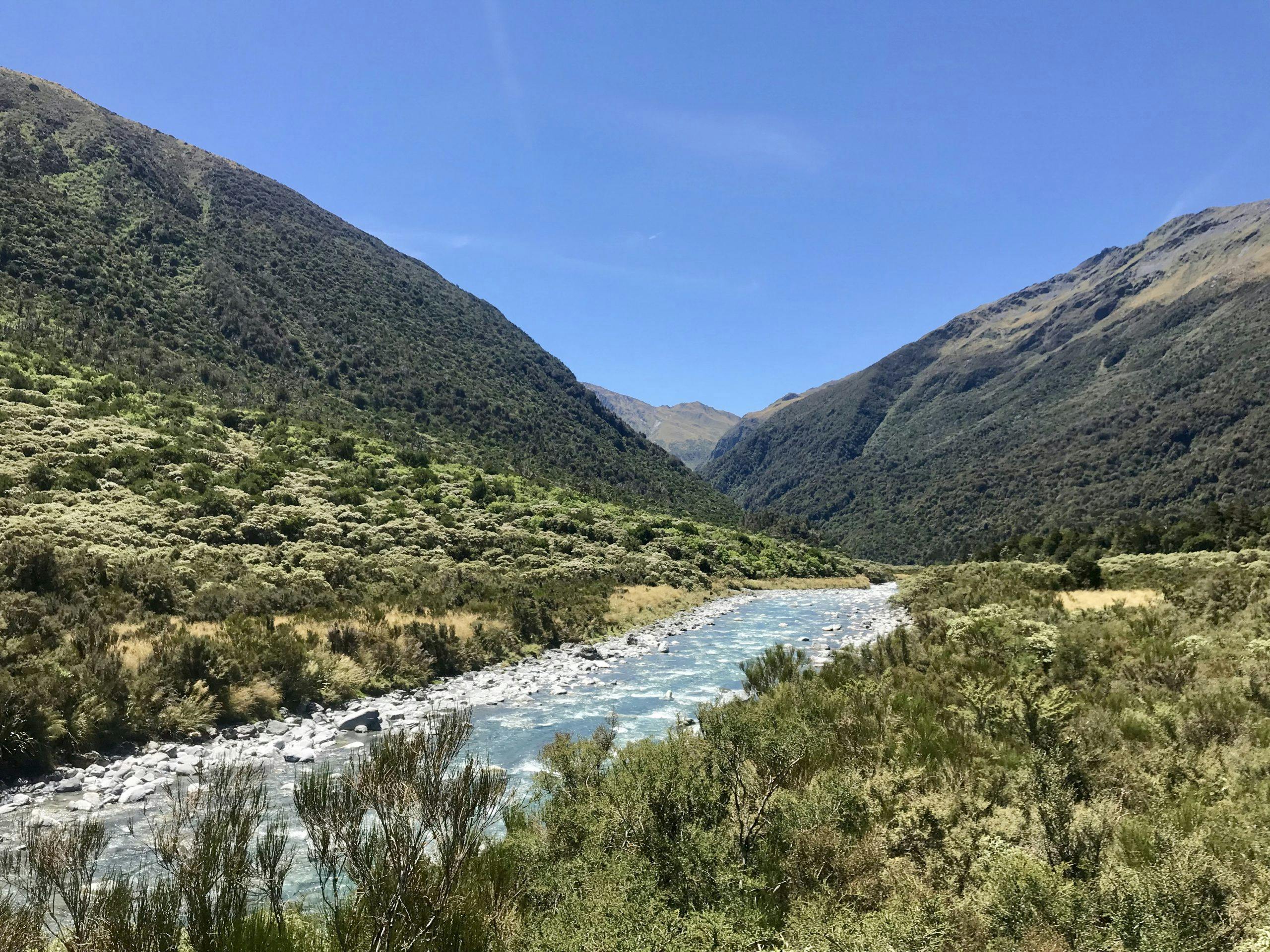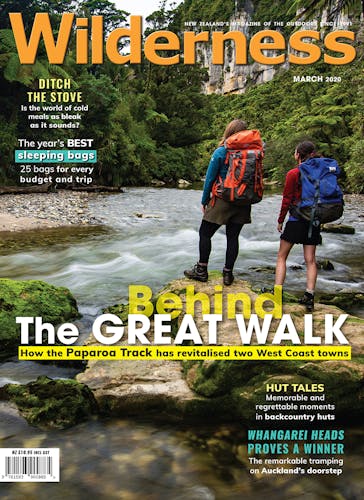Keri Algar enjoys wet boots and outdoor friendship on an Arahura-Styx trip
It’s while reading George Santayana’s essay, The Philosophy of Travel, that I discover an eloquent answer to the question which rubs like sand in my brain during all long walks: why am I doing this?
Writes the Spanish-born philosopher: ‘We need sometimes to escape into open solitudes, into aimlessness, into the moral holiday of running some pure hazard, in order to sharpen the edge of life, to taste hardship, and to be compelled to work desperately for a moment at no matter what.’
Reflecting on my first multi-day tramp in New Zealand, I find his words true to tramping in general.
I’ve managed a couple of multi-day trips, but I have not been self-sufficient.
For three days I trudged over mountains in the Solomon Islands with guides and pack carriers. Then there was an eight-day tapas bar crawl in Spain, also known as the Camino de Santiago.
I’m somewhat wary then, when family friend and veteran tramper, Mary, suggests I join her on the Arahura-Styx at Christmas. We’re talking about a four-day backcountry tramp complete with carrying a pack, cooking gear, and food – plus the promise of permanently wet boots. Even mum frowns doubtfully and points out the obvious, which is that Mary, despite being 30 years my senior, is fitter than me and tougher than the boots she wears out annually.
“Have a look into it,” Mary says.
Just inland of Hokitika, the Arahura-Styx loops around the Newton Range via eponymous river valleys connected by Styx Saddle. DOC considers it an ‘advanced’ track and advises there are slips to negotiate along the Styx River and a warning for crossing it at other than normal flow.
As a persistent traveller and a Kiwi who has lived abroad for most of her life, the allure of a West Coast tramp is strong: Mary’s invitation is an opportunity to reconnect that part of my soul with a place I still call home.
So I borrow a pack, haul hiking pants from storage, and check my boots for nasty Australian spiders. Gratefully, I rely on Mary for everything else: what and how much food to carry, topographical maps, hut passes, pick-ups and drop-offs, checking the weather. She also invites Gavin, an affable Wellingtonian, whom she met living in Papua New Guinea many moons ago.
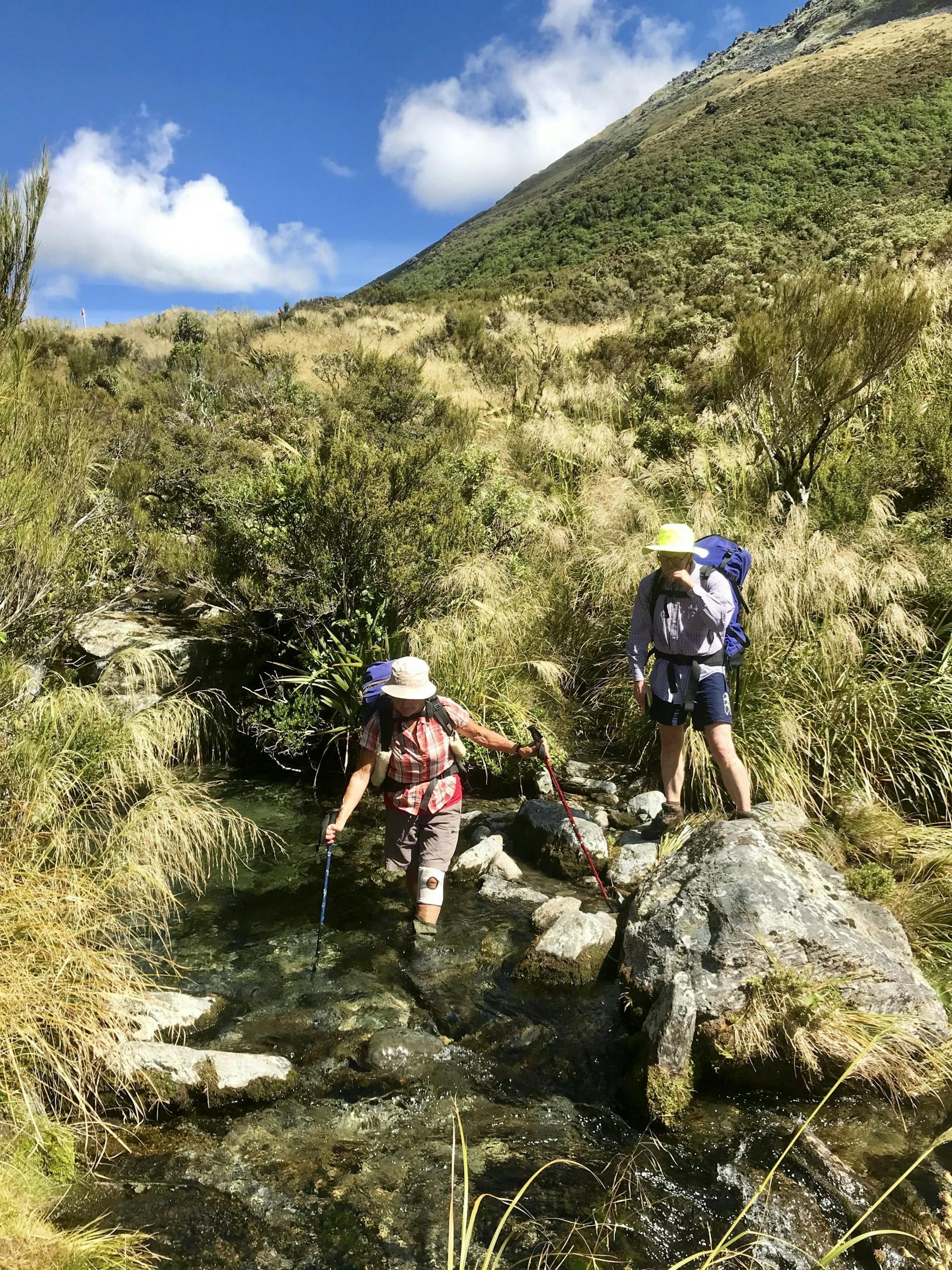
On a sparkling summer’s day, we set off up the Styx River to get the crossing out of the way in dry weather. Stepping off the farmer’s land and onto the riverbed I’m reminded of how easy it is to find ‘open solitudes’ in New Zealand.
Already we’re awash in wilderness. The lower Styx skirts the southern side of Lake Kaniere; just downstream it will converge into the Kokatahi River, a major tributary of the Hokitika River. We follow the map’s directions, walking upstream on the true right of the river. Soon the valley narrows and we’re enveloped in bush-clad mountains.
Mary has the map, Gavin has the app, and my contribution is to help spot track markers – a detail which is unfortunately lost on me. The GPS on Gavin’s app confirms our predicament: red crosshairs pinpoint us on the Styx, some distance from the dotted orange track line in the bush.
We could bushwhack, but the track weaves in and out between bush and river for the remainder of the day. Mary’s no-nonsense attitude prevails. She moves to tramp on, Gavin looks a little unsure, and I’m left pondering how I missed a big orange triangle in a slate grey and green landscape.
Being off track slows our progress considerably. Our conversation is now sporadic. We’re forced to pick a path between boulders, haul ourselves over steep bluffs where turquoise whorls have gouged out the riverbed, and tug ourselves free from grabby bush.
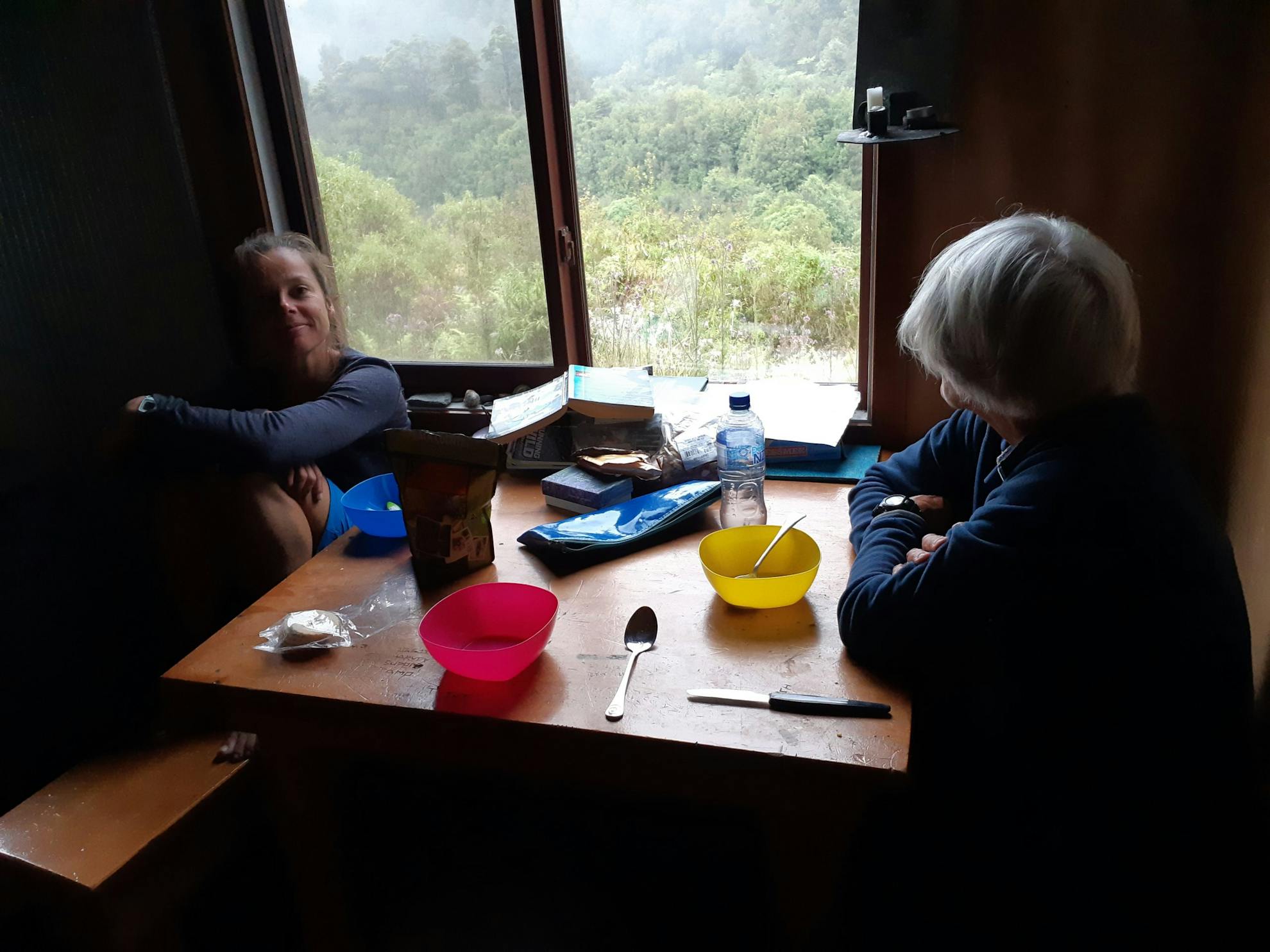
Travel, toil, tramp, travail. Perhaps these words similarly jumbled about the minds of the track’s pioneers when they were ‘compelled to work desperately’.
Most of the Arahura-Styx Track was built in the gold rush of the 1860s for exploration, and to connect the West Coast goldfields with Canterbury over Browning Pass/Noti Raureka and via the Wilberforce River.
I suppose modern-day tramping has its roots in the early European exploration and settlement of the land. Do trampers share a semblance of this pioneering spirit with their forebears? Certainly, then as now, we are bonding with the land.
Our detour adds an hour or two to an already long day – a tiny ‘taste of hardship’ – before we rejoin the pioneer’s path. The spongy ground is a pleasure to walk on after hard river rock. Like my mother’s garden, it’s hedged with pittosporum. Also beech trees, horopito, flax, kawakawa and occasionally there is fledgeling rimu to admire, elegant-looking with limber limbs.
It’s time to cross the Styx.
Coincidentally, The Philosophy of Travel references this river because it’s Hermes, the Greek god of travel, who guides people to the Styx and into the underworld.
Without Hermes, it’s an easy mid-thigh wade across – not to the underworld, but to an otherworldly landscape by contrast. From a confined valley, we’ve arrived at an expansive tussock-studded flatland between the Newton and Browning ranges, a backcountry watercolour of blue, beige and green brushstrokes. Ahead, the evening sun casts a golden glow on Grassy Flat Hut – a welcome sight for weary souls.
I’m not the only one finding home in the bush. Already at the hut, there are three Brits, two of whom emigrated from England six years ago and are very keen trampers, and a third who is considering migrating here, too. From Christchurch, the couple tramp at every opportunity; long weekends, annual leave, you name it.
And why not. ‘Migration,’ writes Santayana, ‘like birth is heroic: the soul is signing away her safety for a blank cheque.’ In New Zealand, this amounts to 10,000km of walking tracks nationally and 700 huts in the South Island alone. The most Kiwi of hobbies is accessible, healthy, and affordable. I get the feeling they’ve adopted it as a way of connecting with their New Zealand identity.
Predictably, the chat turns to the weather, the most Kiwi of conversations.
Under clear mid-summer skies, dusk is a drawn-out affair before finally all light in the west is extinguished.
A boot-wetting creek crossing kick-starts the day, followed by a steady rise upstream to reach Styx Saddle, low slung at 770m. I expected brittle schist above the treeline, instead, tall pole markers guide us through a labyrinth of giant tussock. We hop from the bristly edges of one tussock to the next to avoid the boggy holes in between. Jagged peaks surround the saddle, Mt Browning (1585m) due south.
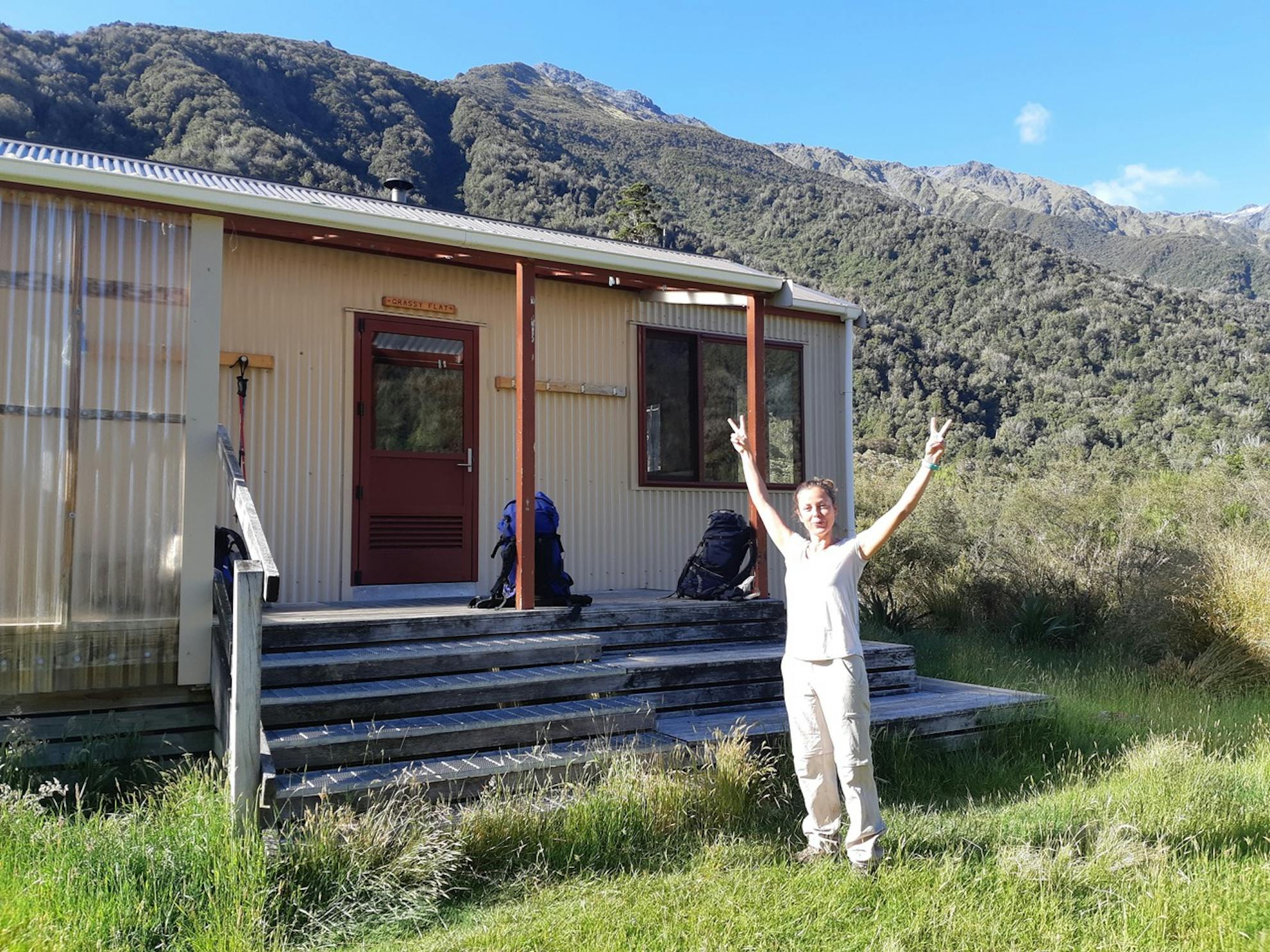
We come across a creek pool recommended during the hut chat. Mary and Gavin are keen for a frigid dip. Stoically, Mary strips first. Next is Gavin. When I see the widening of his eyes and a sharp intake of breath, I know I’ll never get in. It stands to reason they’re now bent on a brew up.
“This is what tramping’s about!” Mary beams.
We descend along a comfortable track verging the valley with views of the Arahura River below. Perched on a branch overhanging the path sits a fat kererū.
There has been a notable lack of birdsong. This is despite a stoat and rat trap set every 100m as part of an intensive pest eradication programme along the whole circuit, which, combined with breeding assistance, has garnered positive results in terms of reported whio numbers.
Both the Styx and Arahura valleys are considered prime places to see the endemic blue duck, which is considered rarer than some species of kiwi. It’s a taonga species to Māori.
As Gavin points out, if I think the lack of birdlife is grim, imagine if such programmes didn’t exist.
At a stubby cliff edge, we’re met with a wide, dry riverbed that further down leads into the Arahura. We look around, perplexed. There’s no obvious path down, no rope to descend along, and no orange marker on the other side to aim for, nor opening through the bush.
A swingbridge over the Arahura takes us to Mudflats Hut, which is actually perched on a rather steep hillside. We arrive to a taciturn woman, tall and fit looking, reading on a Kindle while her partner is attempting a nearby summit. He returns – equally strong-featured – not having reached what he’d hoped. While Mary, Gavin and I discuss who’s getting the top bunk, they pack up and ship off, in search of solitude I suspect. And we get a bottom bunk each.
We are amazed – and awoken – at around 10.30pm to the stomping of boots of a father-son duo who’ve come up via the Arahura, having skipped Lower Arahura Hut. While they wolf down sandwiches by torchlight we learn they’re longtime Hokitika locals – originally Welsh immigrants – and know the track well. The son now lives in the North Island; this walk is bonding time. So is watching the cricket, and they’re up early the next morning to get back to the match.
At last, rain. Water is omnipresent on the Coast, and its sound has been with us all the way, from the roar of the Styx to bubbling brooks to the squelching of my boots. We welcome the rain as it changes the scenery before us.
By nature, the Arahura Valley appears more humid. There are more ferns of many varieties; tall tree ferns, knee-high ferns and tiny ferns with delicate round-leaflets. I’m peeved at myself for not knowing how to identify a silver fern.
It’s a mellow day. No bluffs or slips to negotiate. We tramp on in the damp and before we know it, we stumble across Lower Arahura Hut.
After a day of drizzle, the hut is cold (for me). I’m quick to accommodate the slightest suggestion of lighting a fire by gathering and chopping wood. So ends our last night in the bush; cosy, by a fire, eating chocolate left for us by the Welshmen, playing cards, sharing stories, reading left behind Wilderness magazines, drying wet gear. Out the window, swathes of mist roil in and out and around the valley.
There’s something missing, or perhaps it’s implicit, in Santayana’s philosophy. People. The value of good company. Obviously, I’d be lost without Mary and Gavin’s orienteering skills but beyond this, we’ve enjoyed an easy companionability that’s really made the tramp for me. In other words, Kiwi mateship.
As for home, I’ve come to terms with the idea that I’ll find it wherever my feet are in each present moment. I have a feeling they’ll be back in boots soon enough.
- Distance
- 38.5km
- Total Ascent
- 1881m
- Grade
- Moderate / Difficult
- Time
- Styx Road End to Grassy Flat Hut, 5hr; To Styx Saddle, 1.5hr; To Mudflats Hut, 2.5hr; To Lower Arahura Hut, 5hr; To road end, 3.5hr
- Accom.
- Grassy Flat Hut ($5, ten bunks); Mudflats Hut ($5, six bunks); Lower Arahura Hut ($5, six bunks)
- Access
- At Lake Kaniere from Dorothy Falls Road
- Map
- BV19, BV20
GPX File
- Arahura-Styx (gpx, 22 KB)
GPX File
- Your device does not support GPX files. Please try a different device.





